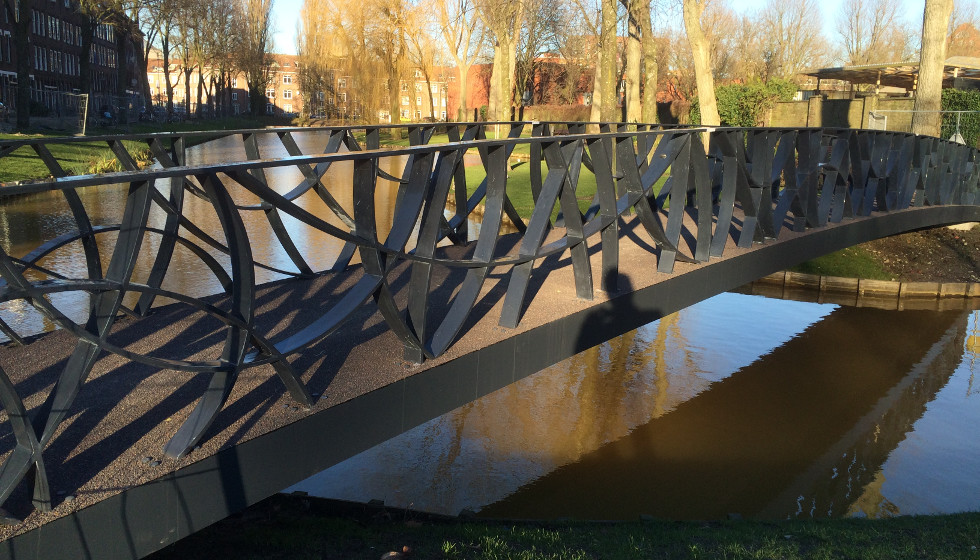Local government opts for leaner and lighter
FiberCore sets new standard with sandwiched composite bridge
Municipalities and counties are becoming increasingly familiar with composite bridges as an alternative to steel or concrete. Government policy is all about sustainability, so environmentally friendly solutions are in demand. With composite bridge decks that guarantee a long lifespan and virtually no maintenance, FiberCore Europe has already convinced many decision-makers of its successful infrastructure product. FiberCore's innovation team in Rotterdam has taken new steps with the introduction of a so-called clamped bridge. This ensures a drastic reduction in construction height as well as a visually attractive design. Because, FiberCore discovered among its customers, the eye also wants something.
In the new version, the abutments are sandwiched. The first experience was gained with the replacement of a bridge on Exercitiestraat in Rotterdam's Crooswijk neighborhood. This project was part of the replacement of many old wooden bridges for cyclists and pedestrians in the city. A large portion of these, over ninety, were subsequently constructed in composite. An important wish of the municipality for the new span in Crooswijk was a slim romantic bridge that requires less material and is lighter. With the advantage that such a bridge is easier and quicker to install, fits in better with the streetscape and has less effect on the environment than thicker variants.
FiberCore then set to work on calculations and, in cooperation with the municipality, came up with a solution in which the bridge deck is clamped to the abutments and is self-supporting. The bridge deck is only 25 cm thick, 20 meters long and 1.5 meters wide. The deck runs over a concrete abutment and has a span of 17 meters. The natural frequency of the bridge was kept sufficiently high so that no annoying vibration could occur. The trapping ensures that this eigenfrequency can be increased. This is possible because of the low weight of the composite in combination with the trapping. This allowed the bridge to be very slender. The abutment consists of a concrete slab supported by two rows of piles for sufficient torque to absorb the support point moment.
Steel sleeves
Steel sleeves with anchor holes are located in the bridge deck. The sleeves run the entire length of the concrete slab and part of the deck itself. They were used to suffice with a limited number of attachment points and to prevent the bridge from bulging on the abutment, creating space between the deck and the concrete slab. Should the anchor connections loosen, the bridge deck is capable of supporting the full load, including safety factors. This is inherent in the fiber-reinforced plastic (composite) used by FiberCore based on its globally patented InfraCore® technology. Steel seemed to be the most suitable material for the handrail, but project partner Jules Dock Composites succeeded in constructing the handrail in composite as well, realizing substantial weight savings and the promise of virtually no maintenance.
Ed Hoogstad, Director of Operations at FiberCore Europe, compares the principle of the clamped bridge to bending a fishing rod. "Long straight bridges are thicker and lie on intermediate supports. A lower construction height allows the material to bend, putting it under tension and assuming a certain stiffness. We managed to halve the construction height on average and clamp the bridge deck to the abutments with appropriate tension. Mind you, while maintaining clearance. As a rule, the length of an embankment increases with the length of the bridge. With a clamped version, the abutments can become less high, requiring, for example, only a half-meter long embankment, whereas otherwise it comes out to five meters. The result is a slimmer bridge that looks attractive and is not even more expensive."
Easier to install
William Schutte, an engineer at the municipality of Rotterdam, was closely involved in the development of this latest FiberCore innovation from the very beginning. Composite is now a popular material at his employer. "We use composite because of its low-maintenance nature, long lifespan and the fact that we need to perform virtually no maintenance. It's also lightweight. In steel, this bridge would be two times heavier, in concrete even four times. The light weight also made the bridge much easier to install than a conventional bridge made of wood or steel simply because the foundation is much lighter. And that saved local residents a lot of inconvenience."
For bicycle and pedestrian bridges, FiberCore can produce up to 40 meters of free span, while maintaining the eigenfrequency in accordance with Eurocode (design regulations). In recent months FiberCore has delivered three clamped composite bridges in Woerden, Gemert and Hattem.
Woerden
Next to railroad tunnel 't Vinkje in Woerden, the new bicycle bridge over the Wulverhorstbaan was placed with a large crane on Friday evening, October 13. The 35-meter long bridge was brought in by special transport in one part outside rush hour and lifted from the truck with a large crane. The bridge provides a safe and comfortable flyover connection for bicycle traffic to and from Woerden and the surrounding area. The bicycle bridge is part of the Zuidelijke Randweg project that contractor company Wallaard Noordeloos is carrying out on behalf of the province of Utrecht. It is one of the contractors with which FiberCore regularly collaborates, including in the large-scale replacement project of the municipality of Rotterdam.
Working with composite in the infrastructure sector experiences Wallaard Noordeloos as particularly pleasant and efficient. "The material is so many times lighter than concrete, so we can transport and install it very comfortably," says deputy director Michael van de Berkt. "Even the trapping on this special variant presented no problems. Within six hours, the bicycle bridge was in place. The period from engineering, including production, to installation required only four months, which is really short for this kind of project." A little further on in Woerden, across the Kromwijker Wetering, another FiberCore composite bicycle bridge will be installed this year. This one will have a length of ten meters.
Gemert
Commissioned by the province of North Brabant, FiberCore has built a bicycle bridge that is part of the Gemert Noord-Om project being carried out by BAM Infra. From the end of 2017, the Noord-Om will form the link between the N605 and the N272 running southeast of Gemert. Sustainability and innovation go hand in hand here. In addition to a special 3D printed bicycle bridge and a retracted traffic circle, the new ring road will feature the longest clamped composite bridge to date under the name Lieve Vrouwesteeg: 37 meters of free span in one piece and a minimal construction height. The bridge, including railings and wearing course, was 'prefabricated' at FiberCore.
"The installation went extremely smoothly," says Rob Leenders, project manager of BAM Infra. "Because the bridge weighs only 26 tons, we were able to install it at lightning speed, in half a day, with no inconvenience to local residents." BAM Infra finds that provinces are increasingly asking for both innovative and sustainable solutions when building new infrastructure. "The application of new materials or new techniques is appreciated and we are happy to play a role in that," says Leenders.
Hattem
In the Assenrade neighborhood of Hattem, a new FiberCore pedestrian and bicycle bridge was installed in July based on a clamped construction. This is another lightweight, slender bridge of 21 meters free span and a construction height of only 29 cm. The municipality is pursuing an active sustainability policy. Assenrade is the last expansion district of Hattem with a high quality and many sustainable applications, including paving and lighting (LED). It is the first time the municipality has chosen composite. "We had no experience with it yet," says Martin Bakker, civil engineer for the municipality of Hattem. "Because we were interested in a slim design with a lot of freedom of form, we studied the FiberCore project in Rotterdam carefully before we made the choice for the sandwiched variant. The municipality of Rotterdam was involved in the design phase as a consultant, so we could make the most of their experience."
Bakker is very pleased. "The result is worth it. The bridge fits perfectly with the atmosphere of the neighborhood with lots of greenery and water and references to the historic character of the city. Because the bridge is light, the foundation could remain limited in size, saving us not only on total lifetime costs, but also on initial investments. And should urban development warrant, we can also easily relocate this bridge."
Foreign country
FiberCore notes that foreign governments are also following the Rotterdam-based company's latest innovation with interest. Clamped composite bridges will soon be installed in Norway and the United Kingdom. The Norwegians can even look forward to a version of as much as 40 meters in length.


